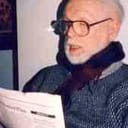Stay in the Loop
BSR publishes on a weekly schedule, with an email newsletter every Wednesday and Thursday morning. There’s no paywall, and subscribing is always free.
Have a conversation (before we forget how)
Stephen Miller's "Conversation'

The last time I saw Stephen Miller was in fall 1981, when he visited my Beaver College media class, unannounced, as I was projecting a slide show of my art tour of Russia that summer. Miller was one of the few members of the English department I had found sufficiently congenial to hold a serious conversation with, although there had been damn few of those, come to think of it.
I left teaching shortly after to become a Welcomat pedagogue, and that was the last I saw of him. Conversation contains allusions to Miller's dispensing grants for the National Endowment of the Humanities and to his high-class journalism (Partisan Review, Wall Street Journal et al) as well as working awhile for a conservative think tank. No more college teaching! Puzzling. He was clearly too good for Beaver.
Anyway, the book is a wonder. We begin this essay on the history of what Miller neologistically calls "the conversible world" with the beginning of language, naturally. A pit stop in Sumer, where a new device— the city— not only encourages conversations but also devises libraries for its cuneiformed records. "Gilgamesh" contains "conversation poems." The genre gets ready to bloom. The Book of Job is scanned for diverse human intercourse. Plato and Socrates up the ante in Athens, while Sparta sets a contrary model of illiterate militarism.
You get the idea. Conversation of steadily growing complexity makes the world seem to go round.
Clubs and coffee houses
Eventually we get to Miller's heroic models, Hume and Doctor Johnson, whose good manners and intellectual brilliance set the high standards this book counsels us not to forget. Coffee houses and private clubs flourish. Miller offers a speedy but not unuseful skittering through American Lit, from Franklin, Thoreau and Whitman (neither good at conversing) to Norman Mailer, whose plea to replicate a culture of the White Negro earns him a big fat F from Professor Miller: Crankiness is not civilized.
Which leads Miller to the late rap artist Eminem, whose foul mouth and misogyny shows how the sleazy '60s misled us.
It's not the postmodern junkies who are killing conversation, in my judgment. It's the solipsism of the electronically isolated that keeps from knowing enough and having good enough manners to share what we've learned that's killing conversation, artful or not. And Miller is good enough at reporting the limitations of the likes of Jerry Springer and Oprah and Rush Limbaugh. He even recommends small neighborly meetings and clubs to keep the art alive. (Yawn.) Pissing in the wind!
What can be done?
The curriculum K-12 must inoculate the masses against our media-born semi-barbarians. Q&A testing won't do it. Teachers who know how to initiate and continue civilized talk in the daily classroom could immediately improve our medians. Trouble is, they've already been gimmicked by the ed schools.
As I read Miller's brilliant 13-page bibliographical essay, which concludes this funky book, I suddenly understood what I'd been mulling over during the several hours I've been reading it. It's a brilliant Ph.D. candidate's oral dissertation. Most of our compatriots, after reading its recommendations, would never ever try to converse again.
The dining-room table, late-night palavers, exemplary adults are the only accessible routes out of the infantilization that has molded our electronic sandbox during the past century. Get a generation of high school teachers to metabolize Miller's intellectual safari, and we'd soon be out of the woods. Otherwise, pass the TV remote.♦
To read a response, click here.
I left teaching shortly after to become a Welcomat pedagogue, and that was the last I saw of him. Conversation contains allusions to Miller's dispensing grants for the National Endowment of the Humanities and to his high-class journalism (Partisan Review, Wall Street Journal et al) as well as working awhile for a conservative think tank. No more college teaching! Puzzling. He was clearly too good for Beaver.
Anyway, the book is a wonder. We begin this essay on the history of what Miller neologistically calls "the conversible world" with the beginning of language, naturally. A pit stop in Sumer, where a new device— the city— not only encourages conversations but also devises libraries for its cuneiformed records. "Gilgamesh" contains "conversation poems." The genre gets ready to bloom. The Book of Job is scanned for diverse human intercourse. Plato and Socrates up the ante in Athens, while Sparta sets a contrary model of illiterate militarism.
You get the idea. Conversation of steadily growing complexity makes the world seem to go round.
Clubs and coffee houses
Eventually we get to Miller's heroic models, Hume and Doctor Johnson, whose good manners and intellectual brilliance set the high standards this book counsels us not to forget. Coffee houses and private clubs flourish. Miller offers a speedy but not unuseful skittering through American Lit, from Franklin, Thoreau and Whitman (neither good at conversing) to Norman Mailer, whose plea to replicate a culture of the White Negro earns him a big fat F from Professor Miller: Crankiness is not civilized.
Which leads Miller to the late rap artist Eminem, whose foul mouth and misogyny shows how the sleazy '60s misled us.
It's not the postmodern junkies who are killing conversation, in my judgment. It's the solipsism of the electronically isolated that keeps from knowing enough and having good enough manners to share what we've learned that's killing conversation, artful or not. And Miller is good enough at reporting the limitations of the likes of Jerry Springer and Oprah and Rush Limbaugh. He even recommends small neighborly meetings and clubs to keep the art alive. (Yawn.) Pissing in the wind!
What can be done?
The curriculum K-12 must inoculate the masses against our media-born semi-barbarians. Q&A testing won't do it. Teachers who know how to initiate and continue civilized talk in the daily classroom could immediately improve our medians. Trouble is, they've already been gimmicked by the ed schools.
As I read Miller's brilliant 13-page bibliographical essay, which concludes this funky book, I suddenly understood what I'd been mulling over during the several hours I've been reading it. It's a brilliant Ph.D. candidate's oral dissertation. Most of our compatriots, after reading its recommendations, would never ever try to converse again.
The dining-room table, late-night palavers, exemplary adults are the only accessible routes out of the infantilization that has molded our electronic sandbox during the past century. Get a generation of high school teachers to metabolize Miller's intellectual safari, and we'd soon be out of the woods. Otherwise, pass the TV remote.♦
To read a response, click here.
What, When, Where
Conversation: A History of a Declining Art. By Stephen Miller. Yale University Press, 2006. 336 pages; $32. yalepress.yale.edu.
Sign up for our newsletter
All of the week's new articles, all in one place. Sign up for the free weekly BSR newsletters, and don't miss a conversation.
 Patrick D. Hazard
Patrick D. Hazard